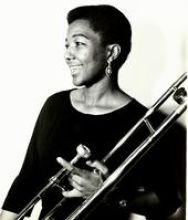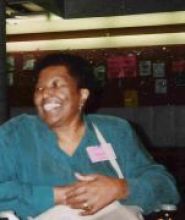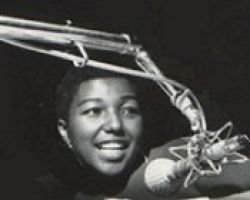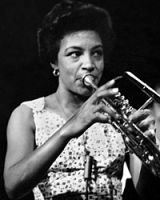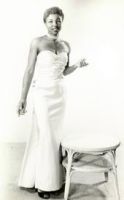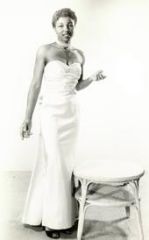|
MELBA LISTON (1926 - 1999) Jazz trombonist, composer, arranger Paved the way for women in jazz roles other than as vocalists Right: Melba with her trombone, 1940s Far right: Melba in 1993, honored at the International Women's Brass Conference. |
|
|
Hear Melba solo with the Dizzy Gillespie Band on her arrangement of My Reverie (1956) |
1926 -- 1936: A Musical Prodigy | 1926 PRICES |
An only child and a musical prodigy, Melba was born in Kansas City, Missouri, in 1926. She said she was raised "between there and Kansas City, Kansas, where my grandparents were." [1] Although she and her mother were poor, they had a piano and a radio. After hearing Fats Waller on the radio when she was six, Melba invented a numbering system so she could notate songs and sing them later. [2] One day she saw a trombone in a store window. “I just had to have it. [It was] beautiful, standing in the shop window like a mannequin, and I was mesmerized by it. I was six or seven. My mom didn’t question it, she just ... got it for me.” [2] At first she had problems with the slide: "I was tall then, but I didn't reach to 6th and 7th position. I used to have to turn my head sideways." [1] Still, by the time she was 8, she was good enough to play a trombone solo on the local radio station. Her mother found her a trombone teacher, but Melba knew right away that he wasn't right for her. "So ... I went on my own. I was always good with my ears, so I could play by ear." [1] | Bread .09/loaf Milk .56/gal Car $275.00 Gas .23/gal Average income: $1,427/year President Calvin Coolidge: "The business of America is business." Ford Motors announced an 8 hour day and a $5 minimum daily wage. Mordecai W. Johnson became the first black president of Howard University. Hot toys: Raggedy Ann dolls, Crayola Crayons Hot books: The Great Gatsby, F. Scott Fitzgerald; The Sun Also Rises, Ernest Hemingway Movies were black & white, and silent until The Jazz Singer (1927) starring singer Al Jolson, a white man, in blackface. |
During the 1920s, stock prices rose to incredible heights. Ads on radio and in newspapers and magazines urged consumers to buy cigarettes, coffee, and Coca-Cola. But on October 29, 1929, the bubble burst. Stock prices plummeted and the country sank into an economic depression. |
1937--1942: A talented teen turns pro | 1937 Prices and Events |
In 1937, in the midst of a worldwide Depression, Melba moved to Los Angeles with her mother. With encouragement from her family and music teachers, she developed her talent in school and local ensembles. Alto saxophonist Vi Redd, a high school classmate, said, "Melba's just always been an advanced musician. We had to struggle to keep up with her." [3] Melba enrolled in a Works Projects Administration (WPA) program run by Alma Hightower, a music educator who directed a band for neighborhood children and stressed the importance of black culture. When Melba turned sixteen in 1942, she left Hightower’s band and joined the Los Angeles Musicians’ Union. She won a job in the pit band at the Lincoln Theater and began writing arrangements for the band. [2] In 1943 she lost the job when the theater stopped featuring live shows, but then a new opportunity presented itself. | Bread: .09/loaf Milk: .50/gal Car: $675 Gas: .20/gal House: $6,622 Ave income: $1,789/year President Franklin D. Roosevelt (FDR). First Lady Eleanor Roosevelt traveled the country, speaking on behalf of FDR, who used a wheelchair due to a childhood bout with polio. Top books: Out of Africa, Isak Dinesen; U.S.A. (trilogy), John Dos Passos Margaret Mitchell wins Pulitzer Prize for "Gone With the Wind." Dirigible Hindenburg exlplodes in flames in New Jersey (36 die). The Golden Gate Bridge opens in San Francisco. |
The 1940s: Good times and bad WW II
|
Melba joined a new band led by trumpeter Gerald Wilson, toured the country and wound up in New York where the band took over from Duke Ellington at the Apollo Theater. The band also recorded back in Los Angeles. In 1947 she did a small group recording with her high school classmate, sax player Dexter Gordon. He dedicated one of his compositions, "Mischievous Lady," to Melba. When Wilson's group disbanded in 1948, she joined Dizzie Gillespie's big band, working with luminaries like saxophonists John Coltrane and Paul Gonsalves and pianist John Lewis. The band was an ear-opening experience. "That was a fantastic band and so different from anything [she had done] in California. The music, the whole attitude and personality of the band was so exciting, I just couldn't believe it." [1] When Dizzy's band broke up in 1949, she rejoined Wilson in a band that accompanied Billie Holiday on a tour of the South. In addition to dealing with Jim Crow laws, they had financial problems. "[Audiences] weren't ready for Billie Holiday and this Bebop band," Melba said, "... they wanted dance music." The audiences grew smaller and smaller. "It wasn't a happy scene and we were on the band bus day and night." [1] They finally sent for money so they could return to California. Disillusioned, Melba gave up music and took an administrative job for the Los Angeles Board of Education for three years. | Fought on land, sea and in the air, World War II dominated the 1940s. Food, gas and other household products were rationed. With so many men away at war, women in unprecedented numbers worked in factories, toiling round the clock to produce planes, ships and war materials. Count Basie recorded “One O’Clock Jump” early in 1942, but that November the American Federation of Musicians issued a ban on recordings. They wanted record companies to pay better royalties to record artists. The recording ban ended late in 1943 when Decca Records agreed to pay AFM members better recording royalties. In 1944, Capitol, Columbia and Victor record companies signed the union agreement. The U.S. military was racially segregated until 1948 when President Harry S. Truman ordered the armed forces desegregated. |
|
|
|
|
A classic African beauty with a graceful bearing and a ready smile, Melba stood tall and slender, with or without her trombone, charming audiences all over the world with her charisma and magnetism. [2] In photo second from left, Melba plays valve trombone in 1958. |
The 1950s: Movie extra to State Department Tour
|
For a time Melba had a brief career in films. In The Prodigal (1955) she did scenes with Lana Turna, walking behind her playing a harp. Then she got a part in the palace orchestra in The Ten Commandments (1956). "I was tall and skinny then," she said. "They said that had they known about me sooner they could have used me in [other movies]." But she never took acting seriously. "It was nice doing those movies, but they're all crazy out there in Hollywood." [1] In 1956, Dizzy Gillespie asked Melba to join his band for a State Department tour of the Middle East and Asia. She played in the band and wrote many of the arrangements. In 1957 she again toured with the band, this time in South America. In both instances, Melba's arrangements were the core of the band library. In 1957 she played with Gillespie's band at the Newport Jazz Festival. A recording of that concert survives as one of the Gillespie band's most exciting albums. |
In 1958 Melba recorded her only album as leader, Melba and Her Bones, with an all-star trombone lineup of Slide Hampton, Jimmy Cleveland, Bennie Green, Frank Rehak, Al Grey and Benny Powell, and a rhythm section of Kenny Burrell, Jamil Nasser and Charlie Persip. Four of the 12 pieces are her compositions. The CD was reissued in 2006. One reviewer said: "Even in the company of high-quality master musicians, her musical skills stand out. Her lyrical improvisations are melodic and clear when she plays unmuted, and mysterious and warm when muted." [4] |
|
A chance encounter in 1958 led to a musical collaboration that lasted 40 years. Jazz pianist and composer Randy Weston, the jazz world’s leading proponent of African music and culture recalls: “I was listening to Dizzy’s band at Birdland and saw this beautiful woman playing the trombone. It was Melba Liston, featured on her own arrangement of ‘My Reverie.’ When I introduced myself and we shook hands, it was like electricity.” Melba played trombone on several Weston albums and wrote arrangements for ten albums, from Little Niles (1959) through Khepera (1998). [7] | |
In 1959, she toured Europe with the musical Free and Easy in the Quincy Jones orchestra. For the show, Melba said, "Quincy would write the light tunes. Ernie Wilkins wrote the hard-swinging Basie-type numbers, and I did the ballads and standards." [1] The band was onstage during much of the show. "They put [Melba] in long white gowns," said saxophonist Phil Woods. "Melba, being so beautiful, was onstage more than the saxophones. She's got a great face." [1A] Photo at right: Melba in her gown Despite the show's popularity, there were financial problems. The musicians returned to New York to play for Quincy Jones' big band. |
|
The 1960s and 70s: Freelance arranger and master teacher |
For much of the 1960s, Melba worked in New York playing studio sessions and writing arrangements. She arranged albums for Marvin Gaye, Billy Eckstine and The Supremes. As arranger-conductor for Riverside Records, she scored music for albums by Milt Jackson, Randy Weston, Gloria Lynne and Johnny Griffin. She worked often with trumpeter Clark Terry, who held her in high esteem. "Melba's charts are fantastic. She has to be one of the all-time great arrangers." She also played for bassist Charlie Mingus, appearing at his famous New York Town Hall concert in 1962. From 1973 to 1979 Melba lived in Jamaica, teaching at the University of the West Indies and directing the Department of Popular Music Studies at the Jamaica Institute of Music . In 1979, the first all-woman jazz festival in Kansas City brought her back to the United States. Her all-woman septet, Melba Liston and Company, was the hit of the festival. Later it became a mixed gender unit, performing at European jazz festivals and in New York City, including Carnegie Hall, until 1983. [5] |
The 1980s and 1990s: Despite a setback, the honors continue | |
In 1985 a stroke left Melba's right side paralyzed, effectively ending her playing career, but her determination and dedication to music inspired her to continue working as a composer and arranger. “Even though she’s in a wheelchair and paralyzed on one side,” Randy Weston recalled in an interview shortly before her death in 1999, “she still writes with her left hand on a computer.” [7]
In 1987 the National Endowment for the Arts named her a Jazz Master, its highest honor in jazz. The honors continued throughout the 1990s. In 1991, New York’s Lincoln Center first jazz concert, “Blues to Africa,” presented Randy Weston's Big Band in works arranged by Melba. | |
In 1993 the first International Women’s Brass Conference (IWBC) honored Melba as a brasswomen pioneer Photo at right: Melba Liston and Susan Fleet, 1993 In 1994 Hip Bones: The Year of the Trombone Jazz Festival (Berkeley, CA, ) was dedicated to Melba, and Carnegie Hall featured her big-band charts in a tribute to women in jazz.
In 1995: The Smithsonian interviewed Melba for its prestigious Jazz Oral History project. |
|
Although too ill to accept, Melba was invited to share a residency with Randy Weston at Harvard University in 1999; the concert by Weston’s African Rhythms and the Harvard Jazz Band (Tom Everett, director) featured Melba’s arrangements. "Hi-Fly,” “My Reverie,” and her 1967 composition “Len Sirrah” receive standing ovations. [7, 7a] |
COMMENTARY LEGACY: On an instrument not often played by women, and working in a field dominated by men, Melba Liston earned raves from players and critics alike, paving the way for other jazzwomen. Her musical style ran from blues to bebop and beyond. Even so, her trombone solos were always lyrical and strongly rhythmic. As an arranger, her command of big band and bebop idioms and her ability to blend African rhythms and percussion with brass and woodwind parts in large scale works was, in the minds of many, equal to the work of Miles Davis and Gil Evans. MENTORS: Dexter Gordon, Dizzie Gillespie, Mary Lou Williams, Clark Terry and, perhaps most importantly, Randy Weston. IMPORTANT COLLABORATIONS: She composed and arranged for Duke Ellington, Count Basie, Freddie Hubbard and Art Blakey, and singers Tony Bennett, Eddie Fisher, Abbie Lincoln, Dinah Washington, Aretha Franklin, Ray Charles, and for the Buffalo Symphony Orchestra. [2, 5, 6] IDOLS: pianist, composer-arranger Mary Lou Williams (1910-1981) and trumpeter and composer, Valaida Snow (1903-1956). “Valaida was beautiful and talented and smart," Melba said, "but she never seemed happy when I knew her.” [8] INFLUENCES: "My big influences were Tommy Dorsey and Lawrence Brown, but I didn't work towards being a front line soloist," Melba said. "I was a slow player, a ballads and blues player." [1] GENDER ISSUES: “I had to prove myself, just like Jackie Robinson,” she said. But after gaining acceptance from male musicians, she was “... free all over the world. Musicians will take care of Melba.” However, she believed women musicians were not given enough credit for their contributions. Citing blues singer Bessie Smith’s influence in the 1920s and ‘30s when black women were the top performers, Melba said: “... if it wasn’t for the women there wouldn’t be no culture a-tall, a-tall.” [2] |
See Melba (briefly) in the Quincy Jones Band (1960) And again in another view of Quincy Jones Band (1960) Selected Discography Melba appeared on more than 50 recordings As Performer: Melba and Her Bones (1958) Columbia, produced by Leonard Feather, reissued 2006 Gerald Wilson and his Orchestra: 1945-1946, reissued on Classics, 1997 BeBop Revisited: Dexter Gordon leader, 1947; reissued 2001 Xandau Birks Works, Dizzy Gillespie leader, Melba on all tracks of 1956-1957 sessions, reissued 1995, Verve Dizzy in South America, Vol. 1 & 2, CAP (1956) Dizzie Gillespie’s band Newport Live, 1957 recording of Dizzy Gillespie band, includes one of her famous improvisation on Gillespie’s “Cool Breeze.” Polygram, 1992 reissue The Jazz Messenger Plus Four, 1957, Art Blakey leader Forty Years of Women in Jazz, a Double Disc Feminist Retrospective, Jass Records (1989), reissue of “My Reverie” trombone solo with Dizzy Gillespie band (1956) As Composer/Arranger: Q Live in Paris, Warner Brothers (1960) Quincy Jones leader A few of her collaborations with Randy Weston: Uhuru Afrika/Highlife, Capitol (reissue of 60s); Tanjah, Verve (1973); Spirits of our Ancestors, Verve (1992); Volcano Blues, Verve (1993); Khepera, Verve (1998) |
SOURCES: 1. Obituary, The Independent of London, Steve Voce (4-27-1999) 1A. Honored Trombonist/Arranger/Composer Melba Liston Dies, Drew Wheeler 2. Stormy Weather: the Music and Lives of a Century of Jazzwomen, Linda Dahl, 1994
3. Melba Liston: Bones of An Arranger: Jazz Profiles, NPR 4. Melba Liston and Her 'Bones, CD review by Hrayr Attarian
5. “Melba Liston, Jazz Master,” Pat Mullan, Jazz Now, reproduced in IWBC Newsletter, Volume 2, Number 2: October, 1995 6. Jazz Masters, a National Endowment for the Arts publication, 2004 7. “Africa’s jazz messenger,” Bob Blumenthal, Boston Globe, interview (4-6-1999) with Randy Weston during his residency at Harvard University 7a. Concert review, Bob Blumenthal, Boston Globe, 4-19-1999 8. Conversations between Susan Fleet and Melba Liston, May 1993 An obituary appears in the New York Times, Peter Watrous, April 30, 1999 |
© copyright 2007 Susan Fleet




